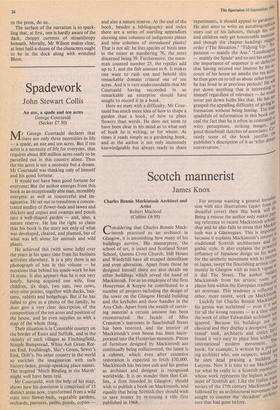Scotch mannerist
James Knox
Considering that Charles Rennie Mack- Ni.,intosh practised as an architect in Glasgow, it is astonishing how many of his buildings survive. His masterpiece, the school of art, is intact and Scotland Street School, Queens Cross Church, Hill House and Windyhill have all escaped demolition and even alteration. Apart from those he designed himself there are also details on other buildings which reveal the hand of Mackintosh. For as an employee of the firm Honeyman & Keppie he contributed to a number of projects including the design of the tower on the Glasgow Herald building and the keyholes and door handles in the Arts Club. Apart from the wealth of surviv- ing material a certain amount has been reconstructed: the façade of Miss Cranston's tearooms in Sauchiehall Street has been restored, and the interior of Mackintosh's own house has been incor- porated into the Hunterian museum. Pieces of furniture designed by Mackintosh are continually being rediscovered, the latest is a cabinet, which even after extensive restoration is expected to fetch £70,000. Mackintosh has become cult and his genius as architect and designer is recognised worldwide. It is no wonder then that Col- lins, a firm founded in Glasgow, should wish to publish a book on Mackintosh, and equally that being Scottish they should wish to save money by re-issuing a title first published in 1968. For anyone wanting a general introde tion with nice illustrations (apart from dreadful cover) then this book will cif,. Being a reissue the author only makes Oa', ing reference to recent Mackintosh sch9,17„, ship and he also fails to stress that Mact',"/ tosh was a Glaswegian. This is imnorta!ii because it explains Mackintosh's interest le traditional Scottish architecture arid trill gothic style. It also explains the pnwer1411 influence of Japanese design on his vild',1 for the aesthetic movement with its inter'-',. in Japan, swept the flourishing artistic cdwas munity in Glasgow with as much vignurses it did Tite Street. The author isnla:d Mackintosh from his artistic roots a" f places him within the European tradition °,1 art nouveau. This tendency is reflected other, more recent, work on Mackint°s,j; Luckily for Charles Rennie Mackintd',,s his genius was acclaimed — even if it v1:0 for all the wrong reasons — at a time te,s the work of other Edwardian architects ignored. Because his buildings are "c. classical and they display a deceptive lfarl,e tional' look, architects and critics ini,`e found it very easy to place him within 1,11.s international modern movement. "ri!!., book, for example, is written by a practio't ing architect who, one suspects, would ntri be seen dead praising a buildintos g II i Lutyens. Now it is time to see Mackin for what he really is: a Scottish manne,r1,,se: whose work represents the highest achle",,, ment of Scottish art. Like the Italian 013:5 nerists of the 17th century Mackintosh It followed by an architectural movement that followed
to counter the 'decadent' arc'ite lure that had gone before.






































 Previous page
Previous page